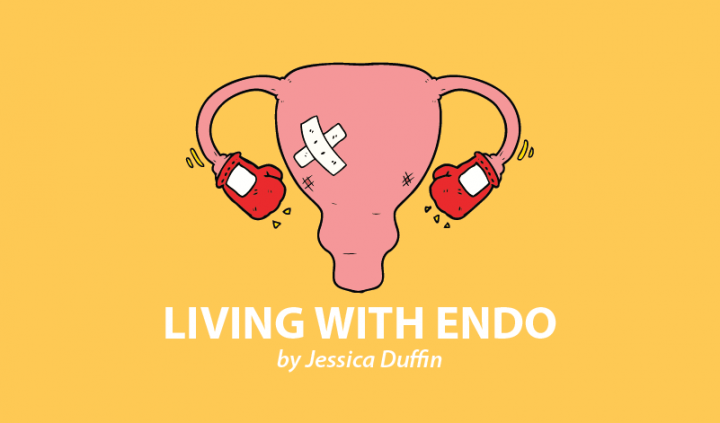“What do you eat in the middle of a pain flare on your period?”
Last night, I hosted a workshop. When this question came up, the rest of the group wanted to know the answer, too, and I totally understand why.
It took me years to discover what worked for me, because at the time, I didn’t have the knowledge and training I have now. Hopefully, by sharing what I eat today, you can skip all those years of confusion and pain.
First, I want to reiterate that I manage my endometriosis all month long, and that’s how I teach my clients to alleviate their symptoms and get their endo under control, too.
However, while I do my best to avoid frantically having to clear up any inflammatory mess I’ve made earlier in the month (we’re all human!), I do start to tweak my diet just before my period. I’ve found that a low-carbohydrate, high-protein, and high-healthy fats approach that includes plenty of greens and colorful vegetables is much better for me leading up to my period.
This approach is different from the popular cycle-syncing approach, which often involves eating apples, pears, dates, brown rice, millet, and sweet potato, among many other healthy and delicious foods, during the luteal phase of the menstrual cycle. Now, I want to be clear — I love the cycle-syncing method of eating. When I follow it, my cycles feel incredible.
However, I’ve noticed that high-fructose and starchy foods can increase pain levels in some of us with endo, due to elevated blood sugar levels. In theory, the impact shouldn’t be too dramatic because of all the wonderful fiber found in fruits like pears and apples. But I’ve tested this out multiple times, and I just don’t do well when I consume too much fruit before my period. That’s not to say everyone will have this experience, but it’s what I’ve observed in my clients and myself.
So, now that I’ve explained what I eat before my period, let’s dive into what I eat when it starts.
Despite having my endo under control, days one and two can unravel pretty quickly if I eat something that doesn’t work for me.
It’s important for me to be mindful about what I eat if I want to reap the rewards of all of the delicious, anti-inflammatory nutrition I’ve been enjoying that month.
Low fiber and low-starch vegetables
Prostaglandins, lipid compounds that are released during our period, can actually cause diarrhea. People with endo tend to have higher levels of this inflammatory substance, which is why it can be so helpful for us to keep inflammation down overall.
Now that my endo is under control, my bowel habits are usually fine during my period, perhaps a little loose at most. But if I eat a lot of fiber on day one or two, I experience stomach pain and diarrhea, and then my pain begins to creep up.
I also find that my pain increases if I eat high-starch foods, such as root vegetables. As a result, I stick to low-fiber foods and low-starch vegetables, such as cucumbers and tomatoes.
Organic, lean protein
I don’t typically fancy my normal meals when I’m on my period, but I like to eat things that are quick and easy, too.
To help keep my blood sugar stable and to keep me full and satisfied, this is when I have the odd processed food or two, such as good quality vegan sausages or burgers. (Just watch out for trans fat.) I usually go for ones made with pea protein, as they tend to be the lowest in carbohydrates and fiber, as opposed to ones made from beans.
Of course, if you eat meat, ensuring you have some organic, grass-fed meat or wild-caught fish that can be easily thrown in the oven or on the grill could be very helpful.
If my appetite is gone, I opt for a quality protein shake, either alone or blended with ice and neutral-tasting vegetables.
Healthy fats
Again, to help keep my inflammation at bay with even blood sugar levels, I make sure I eat fat with any meal or snack — and I go for the healthy type, too! This might be avocado, olive oil, pumpkin seed butter, or organic, pasture-raised eggs rather than refined oils or trans fats.
Remember, this is just my personal approach. I imagine as my small intestine bacterial overgrowth and cortisol dysregulation ease, my tolerance for other foods during my period will increase, and my blood sugar will become more balanced.
What do you eat when you’re on your period? Have you found any foods that work for you? Please share in the comments below.
***
Note: Endometriosis News is strictly a news and information website about the disease. It does not provide medical advice, diagnosis, or treatment. This content is not intended to be a substitute for professional medical advice, diagnosis, or treatment. Always seek the advice of your physician or other qualified health provider with any questions you may have regarding a medical condition. Never disregard professional medical advice or delay in seeking it because of something you have read on this website. The opinions expressed in this column are not those of Endometriosis News or its parent company, BioNews, and are intended to spark discussion about issues pertaining to endometriosis.

